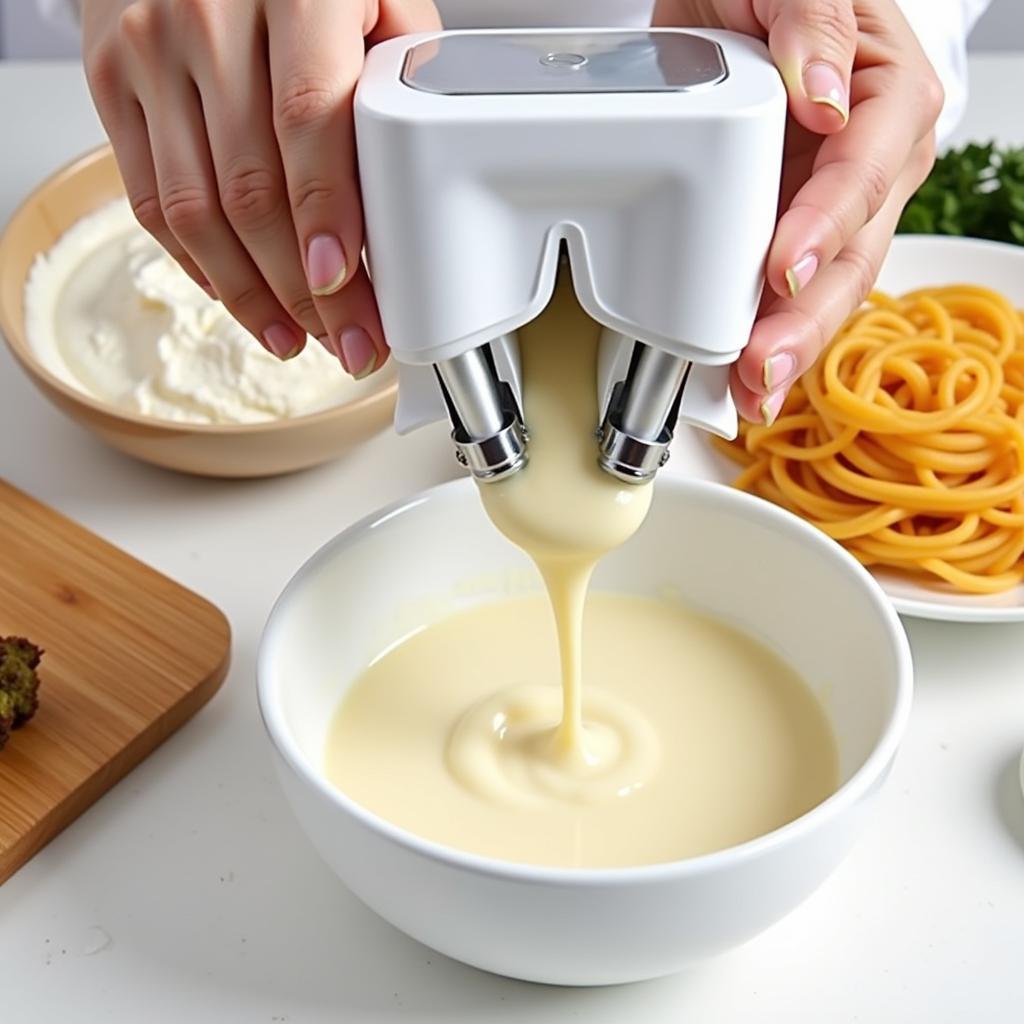A Food Emulsifier Machine is a vital tool for creating smooth, stable mixtures in a variety of culinary applications. From creamy sauces to perfectly textured ice cream, understanding how to use and maintain your emulsifier machine can significantly elevate your culinary creations. This comprehensive guide will delve into the world of food emulsifier machines, exploring their functionalities, benefits, and various applications.
What is a Food Emulsifier Machine?
A food emulsifier machine is a specialized piece of equipment designed to combine two or more immiscible liquids, such as oil and water, into a stable emulsion. This is achieved through high-shear mixing, which breaks down one liquid into tiny droplets and disperses them evenly throughout the other liquid. This process prevents the liquids from separating and creates a homogenous mixture. The size of the droplets and the intensity of the mixing process are crucial factors in determining the stability and texture of the final emulsion.
Benefits of Using a Food Emulsifier Machine
Using a food emulsifier machine offers numerous advantages over traditional mixing methods. These benefits include improved texture, enhanced stability, increased shelf life, and consistent results. Emulsifier machines also allow for precise control over the emulsification process, enabling chefs to create customized emulsions tailored to specific recipes.
- Improved Texture: Achieve smoother, creamier textures in sauces, dressings, and desserts.
- Enhanced Stability: Create emulsions that resist separation, ensuring a consistent product.
- Increased Shelf Life: Extend the shelf life of products by preventing ingredient separation.
- Consistent Results: Produce uniform emulsions every time, regardless of batch size.
 Food emulsifier machine creating a smooth and creamy sauce
Food emulsifier machine creating a smooth and creamy sauce
Types of Food Emulsifier Machines
Several types of food emulsifier machines cater to different needs and production scales. These include high-pressure homogenizers, colloid mills, and rotor-stator mixers. Understanding the differences between these machines is crucial for selecting the right one for your specific application. High-pressure homogenizers are ideal for creating extremely fine emulsions, while colloid mills are suitable for processing thicker materials. Rotor-stator mixers offer versatility and are commonly used in smaller-scale operations.
How to Choose the Right Food Emulsifier Machine?
Choosing the right food emulsifier machine requires careful consideration of several factors. These factors include the type of emulsion you want to create, the viscosity of the ingredients, the required production volume, and your budget.
Considering Your Production Needs
Think about how much product you need to produce regularly. Larger operations will benefit from high-capacity machines, while smaller businesses may find smaller, more versatile models sufficient.
Understanding Viscosity Requirements
Different machines are designed to handle different viscosities. If you’re working with thick ingredients, you’ll need a machine capable of handling high viscosity.
 Various types of food emulsifier machines for different applications
Various types of food emulsifier machines for different applications
Maintaining Your Food Emulsifier Machine
Proper maintenance is essential for ensuring the longevity and optimal performance of your food emulsifier machine. Regular cleaning, lubrication, and inspection are crucial for preventing breakdowns and maintaining hygiene.
Cleaning Procedures for Food Emulsifier Machines
Follow the manufacturer’s instructions for cleaning your specific machine. Generally, this involves disassembling the machine and cleaning each component thoroughly with appropriate cleaning agents.
Regular Maintenance Checks
Regularly inspect the machine for wear and tear, and lubricate moving parts as needed. This preventative maintenance can help avoid costly repairs and downtime.
Applications of Food Emulsifier Machines
Food emulsifier machines are used in a wide range of culinary applications, including the production of sauces, dressings, mayonnaise, ice cream, and beverages. They are also essential for creating stable emulsions in pharmaceutical and cosmetic products.
“Investing in a high-quality food emulsifier machine is a game-changer for any food business. It not only improves product quality but also streamlines production and reduces waste.” – Chef Jean-Pierre Dubois, Culinary Consultant
Conclusion: Elevating Your Culinary Creations with a Food Emulsifier Machine
A food emulsifier machine is a valuable investment for any culinary professional seeking to elevate their creations. By understanding the different types of machines available, their functionalities, and maintenance requirements, you can harness the power of emulsification to create exceptional food products. Choosing the right food emulsifier machine can transform your culinary processes and open up a world of possibilities for creating innovative and delicious food products.
 Food emulsifier machine producing a smooth and creamy ice cream
Food emulsifier machine producing a smooth and creamy ice cream
FAQ
- What is the difference between a homogenizer and a colloid mill?
- How often should I clean my food emulsifier machine?
- What types of food products can be made with an emulsifier machine?
- What is the average lifespan of a food emulsifier machine?
- What is the cost of a food emulsifier machine?
- Are there different sizes of food emulsifier machines available?
- Can a food emulsifier machine be used for non-food applications?
Need support? Contact us at Phone Number: 02437655121, Email: minacones@gmail.com Or visit our address: 3PGH+8R9, ĐT70A, thôn Trung, Bắc Từ Liêm, Hà Nội, Việt Nam. We have a 24/7 customer support team.